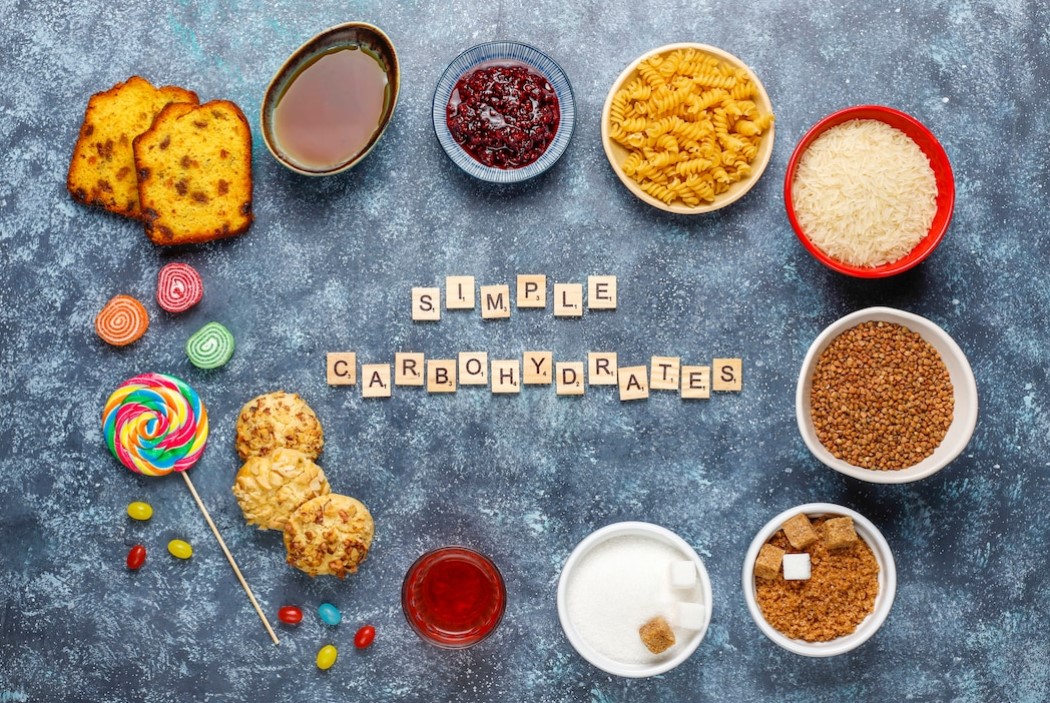We frequently yearn for comfort foods high in bad or simple carbs, such as pasta, fries, pizza, white bread, and sweets. Your health, emotions, and waistline can all be enhanced by choosing healthy carbs instead.
What are simple, refined, or bad carbohydrates?
Sugars and refined grains devoid of bran, fiber, and nutrients, such as those found in white bread, pizza dough, pasta, pastries, white flour, white rice, sweet desserts, and many breakfast cereals, are examples of bad or simple carbs.
They break down quickly, and the dangerous blood sugar spikes they produce are brought on by their high glycemic index. Additionally, they may result in mood and energy swings as well as a buildup of fat, particularly around the waist.
When you consume simple or refined carbohydrates, your bloodstream is overrun with sugar, which causes an increase in insulin to remove the sugar from your blood. After a meal, all much insulin might make you feel hungry again quickly, frequently yearning for more sugary carbohydrates.
You may overeat as a result of this, gain weight, and develop type 2 diabetes and insulin resistance over time. Additionally, high blood pressure, heart disease, obesity, hyperactivity, mood disorders, and even young suicide have all been related to diets high in refined carbohydrates and sugar.
Why is it so challenging to reduce sugar and refined carbs?
Many of us find it difficult to limit our intake of sweets and get rid of our desires for carbohydrates. In addition to being readily apparent in foods like sugary snacks, desserts, and candies, sugar is also a common ingredient in many of the processed foods we consume, including bread, pasta sauce, soda, coffee, and fruit beverages.
But limiting these diet saboteurs doesn’t have to leave you feeling unfulfilled or prevent you from ever again appreciating comfort food. Making the appropriate carb choices is crucial. Complex, whole-grain, or “healthy” carbohydrates such as vegetables, whole grains, and naturally sweet fruit digest more slowly and contribute less to fat storage and stable blood sugar levels.
You can cut back on sugar and simple carbohydrates, stabilize your blood sugar, preserve a healthy weight, and still find methods to sate your sweet desire by putting an emphasis on whole foods and complex, unprocessed carbohydrates. Along with feeling better and having more energy, you might also lose that stubborn belly fat that so many of us fight with.
Sugar and belly fat: The not-so-sweet connection
The liver and abdominal organs are encircled by a lot of belly fat, which is also closely associated with insulin resistance and a higher risk of developing diabetes. Fructose-derived calories are present in processed foods like doughnuts, muffins, cereal, candies, and granola bars.
Sugary drinks like soda, energy and sports drinks, and coffee drinks, are more likely to cause you to gain weight around your midsection. Reducing your intake of sugary foods can help you lose weight and reduce your risk of developing diabetes.
Good and bad carbohydrates
One of your body’s primary sources of energy is carbohydrates. 45 to 65 percent of your daily calories should come from carbohydrates, according to recommendations from health agencies like the U.S. Department of Health and Human Services. However, rather than refined carbohydrates, the majority of these should come from complex, unrefined carbohydrates (including starches such as potatoes and corn).
Complex carbohydrates are absorbed more slowly than simple carbohydrates, which results in a more gradual increase in blood sugar. They typically contain a lot of fiber and nutrients, which can help you lose weight, boost your energy levels, and prevent major diseases. In general, “healthy” carbs have a lower glycemic load and may potentially serve as a preventative measure for type 2 diabetes and future cardiovascular issues.
Good sources of carbohydrates
- Whole wheat or multigrain bread, brown rice, barley, quinoa, bran cereal, and oatmeal are examples of unrefined whole grains.
- Spinach, green beans, Brussels sprouts, celery, and tomatoes are examples of non-starchy vegetables.
- Legumes: lentils, peas, baked beans, kidney beans, etc.
- Nuts include walnuts, cashews, and peanuts.
- Apples, berries, citrus fruit, bananas, pears, and other fruits.
What do glycemic load and glycemic index mean?
The glycemic load (GL) assesses the amount of digestible carbohydrate (total carbohydrate minus fiber) a diet contains, whereas the glycemic index (GI) examines how quickly a food raises your blood sugar. Both can be helpful tools, but it can be confusing to have to utilize various tables. Most people find it simplest to adhere to the general rules of what constitutes a carb as “good” or “bad” unless they are following a particular diet.
Changing to healthy carbs
You don’t have to give up eating French fries or a piece of white bread forever, even though transitioning from simple to complex carbs has many health advantages. After all, it makes sense to crave certain foods more when you forbid them.
Make sugary foods and processed carbs an occasional treat rather than a regular part of your diet. You’ll probably notice a decrease in cravings for these unhealthy meals as you cut back on your consumption.
Sugar added is merely empty calories.
The sugar that naturally appears in food, such as fructose in fruit or lactose in milk, provides your body with all the sugar it needs. The sugar that has been added to processed foods has no nutritional value and merely adds a lot of empty calories, which can ruin any good diet, cause weight gain, and raise your chance of developing significant health issues.
Again, attempting to cut out all sugar and pointless calories from your diet is unreasonable. The American Heart Association advises consuming no more than 100 calories (about 6 teaspoons or 24 grams of sugar) of added sugar per day for women and 150 calories (9 teaspoons or 36 grams) per day for men.
If that’s still too much, keep in mind that a 12-ounce soda can have up to 10 teaspoons of additional sugar, and some shakes and sweetened coffee beverages even more. Currently, 19.5 teaspoons (82 grams) of added sugar are consumed daily by the average American, frequently without them even being aware of it.
You may significantly improve how you look, think, and feel by reducing the amount of sugar in your diet to the advised limits.
How to reduce sugar intake
To give your taste receptors time to adjust and wean yourself off the need, gradually cut back on the sugar in your diet, a little at a time. Make more meals at home. You may make sure that you and your family get fresh, healthy meals without added sugar by cooking more of your own food.
Renovate the recipes. Less sugar works just as well in many dessert recipes.
- Avoid sugary drinks, including those marketed as “diet.” Artificial sweeteners still have the potential to cause sugar cravings that lead to weight gain. Try a little fruit juice in your sparkling water instead of soda. For a tasty, nutritious smoothie, combine skim milk with berries or a banana.
- Steer clear of packaged or processed food. In the United States, canned soups, frozen dinners, and low-fat meals all include added sugar in amounts that can quickly reach harmful levels—roughly 75% of packaged food. In many other nations, the situation isn’t much better.
- When dining out, use caution. Ask for gravy, dressings, and sauces on the side because they typically contain a lot of sugar.
- Consume wholesome snacks. Reduce your intake of sugary treats like candy, chocolate, and cakes. Instead, indulge in naturally sweet foods like fruit, peppers, or natural peanut butter to satisfy your sweet taste.
- Make your own frozen confections. Use plastic spoons as popsicle handles while freezing pure fruit juice in an ice cube tray. Alternately, use pineapple pieces, bananas, grapes, and berries to make frozen fruit kabobs.
- Each packaged food item you purchase should have a label. Select items with reduced sugar content, but be mindful that producers frequently attempt to conceal sugar on labels.
How to recognize hidden sugar in meals
Choosing healthy treats is simply one aspect of the fight to cut back on sugar and simple carbohydrates in your diet. Bread, cereals, canned goods, pasta sauce, margarine, instant mashed potatoes, frozen dinners, low-fat meals, and ketchup are just a few of the grocery store essentials that include sugar. Finding hidden sugar on food labels is the first stage, which may need some detective work:
Despite not being required to distinguish between added sugar and sugar that occurs naturally in the food, manufacturers must list the total amount of sugar on their labels. Although they are included in the ingredients, added sugars aren’t usually obvious as such.
Although it’s not difficult to identify sugar, honey, or molasses, added sugar can also be labeled as corn sweetener, high-fructose corn syrup, evaporated cane juice, agave nectar, cane crystals, invert sugar, or any other kind of fructose, dextrose, lactose, maltose, or syrup.
Contrary to expectations, manufacturers frequently utilize several types of added sugars, which consequently appear spread throughout the list of ingredients for sugary meals. However, all of these tiny amounts of various sweeteners can add up to a significant amount of excess sugar and pointless calories!
If you want to learn more about health-related topics, here’s one about separation anxiety.



